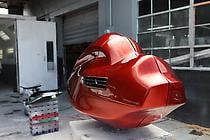DUBAI — This year, for the first time among the nearly 300 galleries fine-tuning their last-minute preparations for Art Basel, there are two galleries from the Gulf region: Green Art Gallery and Gallery Isabelle van den Eynde.
The inclusion of the galleries, both from Dubai, has signaled for many a sign of the maturation of the Middle Eastern art scene and its increasing global presence. “The fact that you have two galleries from the U.A.E. points to the growth of the region in terms of its artists, galleries, institutions and private collectors,” said Marc Spiegler, co-director of Art Basel, which opens Thursday and runs through June 17.
The region’s scene began to rise with the first edition of Art Dubai in 2006 and accelerated with the openings in Doha of the Museum of Islamic Art in 2008 and the Mathaf: Arab Museum of Modern Art in 2010.
Green Art Gallery and Gallery Isabelle van den Eynde are exhibiting in Art Statements, a sector for emerging talent that has catapulted artists like William Kentridge, Takashi Murakami and Elizabeth Peyton to international acclaim. Galleries in this section are selected by the Art Basel committee based on the strength of a proposed project featuring a single artist.
“Any gallery wants to end up in Basel because, like it or not, this is the best fair in the world,” said Yasmin Atassi, the director of Green Art Gallery.
Her gallery will present a multimedia installation by Shadi Habib Allah, a Palestinian artist she signed after he finished a fine arts master’s degree at Columbia University in New York in 2010. Mr. Allah, who says his work questions received ideas, created for this project a work entitled “S/N: 8F1GNA0021,” in which he commissioned a camera to be stolen, stripped of its identifying markers and reassembled as a legitimate object. He documented the process to show the ordinariness of black-market activity.
“Shadi is a very young artist who hasn’t had a lot of visibility, so this is his big break — and it’s ours as well,” said Ms. Atassi, pointing to the exposure to international museums, curators and collectors that being in Art Statements would afford her gallery. “It’s like winning the Oscars!”
Gallery Isabelle van den Eynde will present works on paper and video animation by Rokni Haerizadeh, an Iranian artist living in Dubai.
Incorporating media images of the demonstrations in Iran in June 2009, Mr. Haerizadeh’s works raise questions about the culture of popular protest. In his series “Fictionville, Life is Perhaps That Enclosed Moment when My Vision Destroys Itself in the Pupil of Your Eyes” and “Just What is it That Makes Today’s Homes so Different, so Appealing?” he reinvents the police and protesters as animals.
“What I like about Art Statements is that the selection committee looked at the message of the work, which is very humanistic and full of complex ideas that go deeper than identity issues,” Ms. van den Eynde said.
Referring to the tendency for Middle Eastern artists to be reduced to stereotypes, she added: “We want the focus to be on their work rather than on the passport they hold.”
Art Basel has been increasing its reach since it was founded in Switzerland in 1970. It added Art Basel Miami Beach in 2002 and, starting next year, will open its first Hong Kong edition.
“The strength of Art Basel is that it has expanded as the art world has expanded,” said Mr. Spiegler, the fair’s co-director. And while there are no plans now to start a Middle Eastern edition, he said the fair’s decision last year to appoint a V.I.P. relations manager to the Middle East was evidence that Art Basel took the region seriously.
Ms. Atassi of the Green Art Gallery attributes the increased attention to the growing sophistication of regional institutions and collectors since the financial crash. Since 2010, she said, the “anything goes” buying frenzy has given way to a more subdued environment as collectors have become more critical and artists have responded by producing more nuanced work.
For Ms. van den Eynde, the most important aspect of being included in Art Basel is not the effect it will have on the region, but the wider audience it will bring to view her gallery’s artists.
“Of course there will be collateral advantages for Dubai,” she said. “But the most important for me is that the work will be viewed and criticized by a highly educated and informed audience.”
